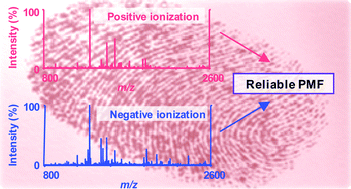A simple and efficient approach to improve protein identification by the peptide mass fingerprinting method: concomitant use of negative ionization
Abstract

* Corresponding authors
a
Laboratory of Bio-analytical Chemistry, Graduate School of Pharmaceutical Sciences, Tohoku University, 6-3 Aramaki-aoba, Aoba-ku, Sendai, Japan
E-mail:
t-oe@mail.pharm.tohoku.ac.jp
Fax: +81 22-795-6816

 Please wait while we load your content...
Something went wrong. Try again?
Please wait while we load your content...
Something went wrong. Try again?
T. Sanaki, M. Suzuki, S. H. Lee, T. Goto and T. Oe, Anal. Methods, 2010, 2, 1144 DOI: 10.1039/C0AY00215A
To request permission to reproduce material from this article, please go to the Copyright Clearance Center request page.
If you are an author contributing to an RSC publication, you do not need to request permission provided correct acknowledgement is given.
If you are the author of this article, you do not need to request permission to reproduce figures and diagrams provided correct acknowledgement is given. If you want to reproduce the whole article in a third-party publication (excluding your thesis/dissertation for which permission is not required) please go to the Copyright Clearance Center request page.
Read more about how to correctly acknowledge RSC content.
 Fetching data from CrossRef.
Fetching data from CrossRef.
This may take some time to load.
Loading related content
